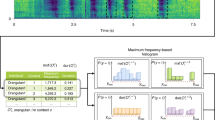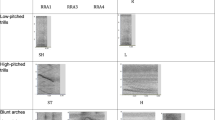Abstract
Individual primates typically produce acoustically distinct calls. To investigate the factors that facilitate the evolution of individual vocal signatures, we examined two components of the call repertoire of chimpanzees: the pant hoot and pant grunt. Pant hoots are long-distance signals whose recipients can be several hundred meters away, while pant grunts are short-range calls given to conspecifics within close visual range. Given their markedly different contexts of emission, we predicted that natural selection would favor the elaboration of individually distinctive acoustic features in pant hoots compared with pant grunts. Analyses of nine acoustic features revealed that pant hoots are more stereotyped within-individuals and variable between-individuals than pant grunts. These data are consistent with the hypothesis that selection may act to encode varying degrees of individuality in different components of the vocal repertoire of a single species.
Similar content being viewed by others
References
Beecher, M., Medvin, M., Stoddard, P., and Loesche, P. (1986). Acoustic adaptations for parent-offspring recognition in swallows.Exp. Biol. 45: 179–193.
Beeman, K. (1992).Signal Software Manual, Engineering Design, Belmont, MA.
Cheney, D., and Seyfarth, R. (1988). Assessment of meaning and the detection of unreliable signals by vervet monkeys.Anim. Behav. 36: 477–486.
Clark, A., and Wrangham, R. (1993). Acoustic analysis of wild chimpanzee pant hoots: Do Kibale Forest chimpanzees have an acoustically distinct food arrival pant hoot?Am. J. Primatol. 31: 99–109.
Dunn, H. (1961). Methods of measuring vowel format bandwidths.J. Acoust. Soc. Am. 33: 1737–1746.
Falls, J. B. (1982). Individual recognition by sound in birds. In Kroodsma, D., and Miller, E. (eds.)Acoustic Communication in Birds, Academic Press, New York, pp. 237–278.
Goodall, J. (1986).The Chimpanzees of Gombe, Belknap Press, Cambridge, MA.
Gouzoules, H., and Gouzoules, S. (1990). Body size effects on the acoustic structure of pigtail macaque(Macaca nemestrina) screams.Ethology 85: 324–334.
Hauser, M. (1992). Articulatory and social factors influence the acoustic structure of rhesus monkey vocalizations: A learned mode of production?J. Acoust. Soc. Am. 91: 2175–2179.
Hayaki, H., Huffman, M., and Nishida, T. (1989). Dominance among male chimpanzees in the Mahale Mountains National Park, Tanzania.Primates 30: 187–197.
Inoue, M. (1988). Age gradations in vocalization and body weight in Japanese monkeys(Macaca fuscata).Folia Primatol. 51: 76–86. Insley, S. (1992). Mother-offspring separation and acoustic stereotypy: A comparison of call morphology in two species of pinnepeds.Behaviour 120: 101–122.
Jolliffe, I. (1986).Principal Components Analysis, Springer-Verlag, New York.
Marier, P. (1957). Specific distinctiveness in the communication signals of birds.Behaviour 11: 11–39.
Marler, P. (1973). A comparison of vocalization of red-tailed monkeys and blue monkeys,Cercopithecus ascanius andC. mitis, in Uganda.Z. Tierpsychol. 33: 233–247.
Marier, P. (1976). Social organization, communication, and graded signals: the chimpanzee and gorilla. In Bateson, P., and Hinde, R. (eds.),Growing Points in Ethology, Cambridge University Press, Cambridge, pp. 239–280.
Marier, P., and Hobbett, L. (1975). Individuality in a long-range vocalization of wild chimpanzees.Z. Tierpsychol. 38: 97–109.
Marier, P., and Tenaza, R. (1977). Signaling behavior of apes with special reference to vocalization. In Sebeok, T. (ed.),How Animals Communicate, Indiana University Press, Bloomington, pp. 965–1003.
Mayr, E. (1963).Animal Species and Evolution, Belknap Press, Cambridge, MA.
Medvin, M., Stoddard, P., and Beecher, M. (1993). Signals for parent-offspring recognition: a comparative analysis of the begging calls of cliff swallows and barn swallows.Anim. Behav. 45: 841–850.
Mitani, J. (1987). Species discrimination of male song in gibbons.Am. J. Primatol. 13: 413–423.
Mitani, J. (1996). Comparative studies of African ape vocal behavior. In McGrew, W., Marchant, L., and Nishida, T. (eds.),Great Ape Societies, Cambridge University Press, Cambridge, pp. 241–254.
Mitani, J., and Gros-Louis, J. (1995). Species and sex differences in the screams of chimpanzees and bonobos.Int. J. Primatol. 16: 393–411.
Mitani, J., and Nishida, T. (1993). Contexts and social correlates of long distance calling by male chimpanzees.Anim. Behav. 45: 735–746.
Nishida, T., and Kawanaka, K. (1972). Inter-unit-group relationships among wild chimpanzees of the Mahali Mountains.Kyoto Univ. Afr. Studies 7: 131–169.
Nishida, T., Takasaki, H., and Takahata, Y. (1990). Demography and reproductive profiles. In Nishida, T. (ed.),The Chimpanzees of the Mahale Mountains, University of Tokyo Press, Tokyo, pp. 63–97.
Scherrer, J. A., and Wilkinson, G. (1993). Evening bat isolation calls provide evidence for heritable signatures.Anim. Behav. 46: 847–860.
Seyfarth, R., and Cheney, D. (1985). The natural vocalizations of non-human primates.Trends Neuroscl. 7: 66–73.
Siegel, S., and Castellan, N. J. (1988).Nonparametric Statistics for the Behavioral Sciences, McGraw-Hill, New York.
Smuts, B., Cheney, D., Seyfarth, R., Wrangham, R., and Struhsaker, T. (1987).Primate Societies, University of Chicago Press, Chicago.
Snowdon, C. (1986). Vocal communication. In Mitchell, G., and Erwin, J. (eds.),Comparative Primate Biology, A. Liss, New York, pp. 495–530.
Sokal, R., and Braumann, C. (1980). Significance tests for coefficients of variation and variability profiles.Syst. Zool. 29: 50–66.
Sokal, R., and Rohlf, F. J. (1995).Biometry, W. H. Freeman, New York.
Uehara, S., and Nishida, T. (1987). Body weights of wild chimpanzees(Pan troglodytes) of the Mahale Mountains National Park, Tanzania.Am. J. Phys. Anthropol. 72: 315–321.
Wiley, R. H. (1983). The evolution of communication: information and manipulation. In Halliday, T., and Slater, P. J. B. (eds.),Animal Behaviour, Vol. 2. Communication, W. H. Freeman, New York, pp. 156–189.
Wiley, R. H. (1994). Error, exaggeration, and deception in animal communication. In Real, L. (ed.),Behavioral Mechanisms in Evolutionary Ecology, University of Chicago Press, Chicago, pp. 157–189.
Wiley, R. H., and Richards, D. (1982). Adaptations for acoustic communication in birds: Sound transmission and signal detection. In Kroodsma, D. E., and Miller, E. H. (eds.),Acoustic Communication in Birds, Academic Press, New York, pp. 131–181.
Zoloth, S., Petersen, M., Beecher, M, Green, S., Marier, P., Moody, D., and Stebbins, W. (1979). Species-specific perceptual processing of vocal sounds by monkeys.Science 204: 870–872.
Author information
Authors and Affiliations
Rights and permissions
About this article
Cite this article
Mitani, J.C., Gros-Louis, J. & Macedonia, J.M. Selection for acoustic individuality within the vocal repertoire of wild chimpanzees. Int J Primatol 17, 569–583 (1996). https://doi.org/10.1007/BF02735192
Received:
Revised:
Accepted:
Issue Date:
DOI: https://doi.org/10.1007/BF02735192




